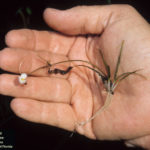Sagittaria graminea
What is Grassy Arrowhead?
Other common spellings and names include: grass leaf arrowhead.
Physical Characteristics
Leaves:
- Straight
- Either thin, wide linear flattened leaf or slender leaf blades
- Bladeless or thinly sword-shaped tapering blades
- Up to 8 inches long & 1 inch wide
Flowers:
- Thread-like ascending
- Spreading pedicels up to 1.19 inches long
- Oval-shaped bracts up to 0.25 inches long
- Sepals oval-shaped, up to 0.2 inches long
- Petals white or rarely pinkish, up to 0.25 inches long
- Bloom Apr – Nov
Fruit:
- Single seed
- Does not open to release seed when ripe
- Oval-shaped
- 0.08 inches long & 0.02 inches wide
- Flat sides or with 1-2 narrow ridges
Stem:
- Simple
- Up to 10 whorls
Roots:
- Rooted in mud
Where Does it Grow?
USDA, NRCS. The PLANTS Database (http://plants.usda.gov). National Plant Data Team, Greensboro, NC 27401-4901 USA.
Grassy arrowhead can be found in the shallow water of ditches, ponds, marshes, or streams.
Pros and Cons of Arrowhead
The tubers of arrowheads are prized foods by ducks, geese, muskrats, and nutria. Seeds are sometimes consumed by ducks. Submerged portions of all aquatic plants provide habitats for many micro and macro invertebrates. These invertebrates in turn are used as food by fish and other wildlife species (e.g. amphibians, reptiles, ducks, etc.). After aquatic plants die, their decomposition by bacteria and fungi provides food (called “detritus”) for many aquatic invertebrates.



